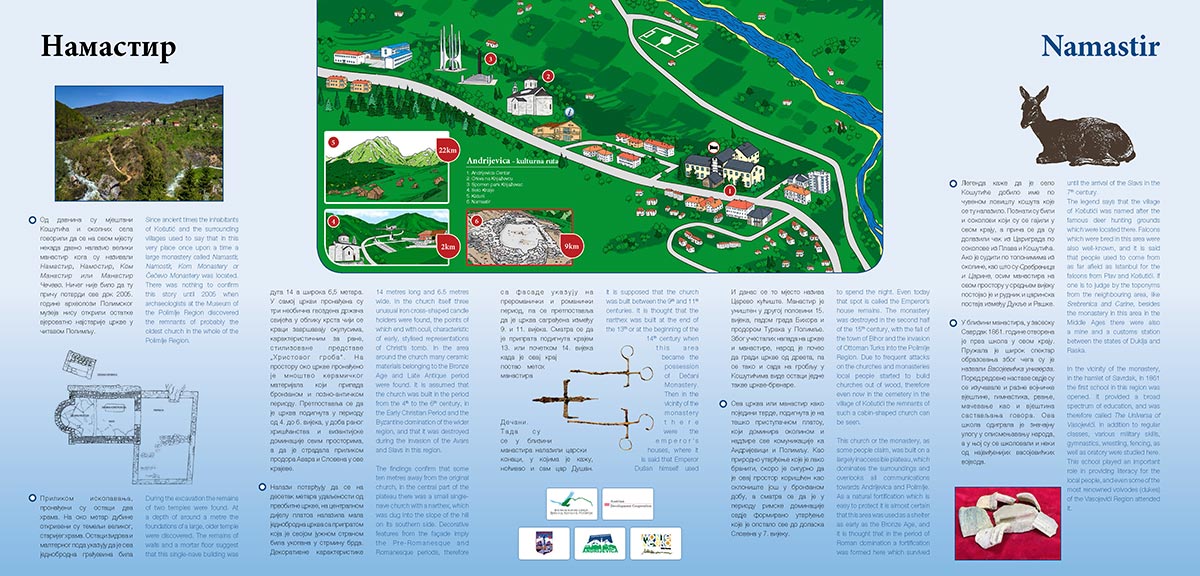Since ancient times the inhabitants of Košutić and the surrounding villages used to say that in this very place once upon a time a large monastery called Namastir, Namostir, Kom Monastery or Čečevo Monastery was located. There was nothing to confirm this story until 2005 when archaeologists at the Museum of the Polimlje Region discovered the remnants of probably the oldest church in the whole of the Polimlje Region.
During the excavation the remains of two temples were found. At a depth of around a metre the foundations of a large, older temple were discovered. The remains of walls and a mortar floor suggest that this single-nave building was 14 metres long and 6.5 metres wide. In the church itself three unusual iron cross-shaped candle holders were found, the points of which end with oculi, characteristic of early, stylised representations of Christ’s tomb. In the area around the church many ceramic materials belonging to the Bronze Age and Late Antique period were found. It is assumed that the church was built in the period from the 4th to the 6th century, in the Early Christian Period and the Byzantine domination of the wider region, and that it was destroyed during the invasion of the Avars and Slavs in this region.
The findings confirm that some ten metres away from the original church, in the central part of the plateau there was a small singlenave church with a narthex, which was dug into the slope of the hill on its southern side. Decorative features from the façade imply the Pre-Romanesque and Romanesque periods, therefore it is supposed that the church was built between the 9th and 11th centuries. It is thought that the narthex was built at the end of the 13th or at the beginning of the 14th century when this area became the possession of Dečani Monastery. Then in the vicinity of the monastery t h e r e were the e m p e r o r ’s houses, where it is said that Emperor Dušan himself used to spend the night. Even today that spot is called the Emperor’s house remains. The monastery was destroyed in the second half of the 15th century, with the fall of the town of Bihor and the invasion of Ottoman Turks into the Polimlje Region. Due to frequent attacks on the churches and monasteries local people started to build churches out of wood, therefore even now in the cemetery in the village of Košutići the remnants of such a cabin-shaped church can be seen.
This church or the monastery, as some people claim, was built on a largely inaccessible plateau, which dominates the surroundings and overlooks all communications towards Andrijevica and Polimlje. As a natural fortification which is easy to protect it is almost certain that this area was used as a shelter as early as the Bronze Age, and it is thought that in the period of Roman domination a fortification was formed here which survived until the arrival of the Slavs in the 7th century.
The legend says that the village of Košutići was named after the famous deer hunting grounds which were located there. Falcons which were bred in this area were also well-known, and it is said that people used to come from as far afield as Istanbul for the falcons from Plav and Košutići. If one is to judge by the toponyms from the neighbouring area, like Srebrenica and Carine, besides the monastery in this area in the Middle Ages there were also a mine and a customs station between the states of Duklja and Raska.
In the vicinity of the monastery, in the hamlet of Savrdak, in 1861 the first school in this region was opened. It provided a broad spectrum of education, and was therefore called The Universa of Vasojevići. In addition to regular classes, various military skills, gymnastics, wrestling, fencing, as well as oratory were studied here. This school played an important role in providing literacy for the local people, and even some of the most renowned voivodes (dukes) of the Vasojevići Region attended it.



